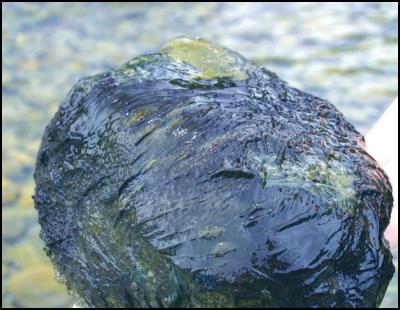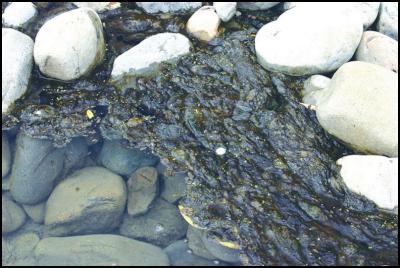Public warned about potentially toxic algae

Images: Greater Wellington Regional Council
Media Release
16 January
2013
Public warned about potentially toxic
algae
Laboratory results have been unable to confirm
whether a dog which died after a walk along the Tukituki
River bank was affected by toxic algae poisoning.
The dog became ill after being taken for a walk along the Tukituki River bank and by a small stock watering pond, it was subsequently euthanised.
The dog’s symptoms and history of contact with water suggested that cyanobacteria poisoning was likely. However an initial survey of the Tukituki River in the vicinity found low to no risk of cynaobacteria and test results from the pond have come back negative for algae toxins.
Hawke’s Bay Regional Council Group Manager – Resource Management Iain Maxwell says while the results were negative in this case algal mats have been found recently in other parts of the river and the incident provides a timely reminder for dog owners to be vigilant with their canines and not allow them to eat any unknown material around the river to avoid poisoning.
He says the growth of potentially toxic blue-green algal mats is common in rivers during periods of low river flow and warm temperatures.
“Prolonged warm, dry weather combined with low river flows may mean that algal mats become exposed or easily accessible to dogs, stock and recreational users,” says Mr Maxwell.

Hawke’s Bay District Health Board Medical Officer of Health Nicholas Jones says any contact with the toxic form of the mat may cause vomiting, diarrhoea, numbness or tingling around the mouth,and skin rashes in humans. He says dogs are particularly susceptible to the toxins which may cause paralysis.
“Rivers users should avoid any contact with algal mats, avoid swimming in water where the mats are present, and keep dogs from scavenging around the river,” says Dr Jones.
The cyanobacteria mats are identifiable by a strong musty odour and can vary in colour from brown/black when in the water to a pale brown/whitish colour when dry.
Dr Jones says if anyone displays signs of illness after being in a river bed they should seek medical advice from a doctor immediately. Similarly, any dogs or other animals that get sick after being in a river should get prompt veterinary attention.
Cyanobacteria is a naturally occurring algae species found in water bodies throughout the country. As part of HBRC’s routine water quality monitoring staff run cross sections to check for the presence of this algae.
For more information on algae toxins visit Hawke’s Bay Regional Council website (www.hbrc.govt.nz )
ENDS


 University of Auckland: Tributes Flow For Much Loved Pacific Leader Melegalenu’u Ah Sam
University of Auckland: Tributes Flow For Much Loved Pacific Leader Melegalenu’u Ah Sam NZEI: Ministry Of Education Cuts Will Disproportionately Affect Pasifika
NZEI: Ministry Of Education Cuts Will Disproportionately Affect Pasifika Day One Hapai te Haeata: Call To Action For Young Filmmakers Against The Backdrop Of Funding Cuts
Day One Hapai te Haeata: Call To Action For Young Filmmakers Against The Backdrop Of Funding Cuts Toyota New Zealand: Three Races For Top Three To Decide TR86 Title
Toyota New Zealand: Three Races For Top Three To Decide TR86 Title Wellington City Council: Wellington Is All Action Stations For The Faultline Ultra Festival
Wellington City Council: Wellington Is All Action Stations For The Faultline Ultra Festival Melanie Allison: Local Playwright Casts A Spell Over Hamilton
Melanie Allison: Local Playwright Casts A Spell Over Hamilton